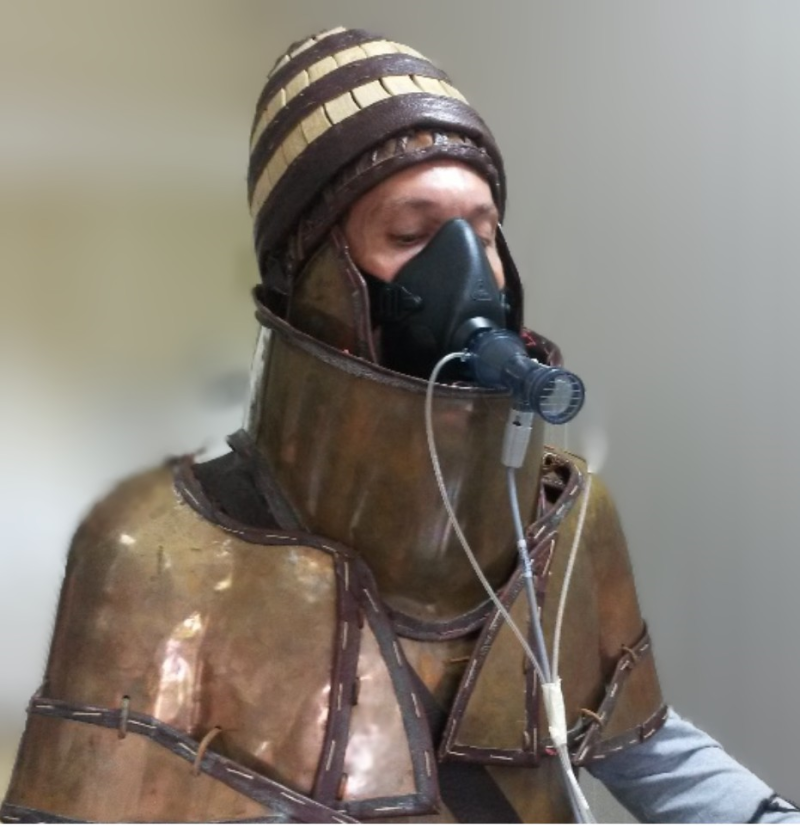The results showed that the armor in question could very well be used on the battlefield, and was not simply a ceremonial garb, as originally stated.
A 3,500-year-old replica of full-body bronze armor, studied at the University of Thessaly, was worn by trained Greek marines following a demanding combat simulation protocol. The study was recently published in a prestigious international scientific journal. The results showed that the armor in question could very well be used on the battlefield, and was not simply a ceremonial garb, as it had originally been stated.
“The best-preserved and almost complete sample of full-body armor of the Mycenaean era consisting of wrought copper plates and dating from the 15th century BC was found in the village of Dendra in the Argolis by Swedish and Greek archaeologists in May 1960. However, since day of its discovery the question that preoccupied experts was: was it used only for ceremonial purposes or was it also intended as an effective weapon of war? Until now, the lack of a documented answer has limited the full understanding of the conditions that prevailed in the war conflicts of the time, which determined the social transformations of the prehistoric world” Professor of Archeology at the University of Birmingham in England and member of the research team Dr Ken Wardle emphasizes to the Athenian-Macedonian News Agency.
The emeritus professor and initiator of the specific study, Dr. Yiannis Koutentakis, continued by also emphasizing to the Athens Agency, that “in order to answer the above question, the innovative collaboration of two seemingly unrelated sciences, archeology and sports physiology, was needed in order to accurately assess the loads caused by the armor on the bodies and biological functions of the volunteers. The results overturn the perception until now, which wanted the armor in question to be simply a ceremonial cloak, mainly due to the supposed cumbersome construction, thus illuminating an important aspect of the Bronze Age in Greece and the Eastern Mediterranean in general. In addition, the findings show the potential of cross-disciplinary collaborations. I hope that the new specialty that was created, that of “archaeophysiology” will be the vehicle for new studies in the future”.
Professor Dr. Andreas Flouris, who led the entire effort, explains: “The replica armor used in our study had the same dimensions and similar weight as the original. Our volunteers strictly followed a “Homeric diet” of about 4,500 calories, which was based on relevant descriptions from the Iliad. During an 11-hour combat protocol, which was also designed following relevant descriptions of the Iliad, we measured the energy expenditure as well as the burdens received by the bodies of the volunteers at temperatures of 30-36 degrees Celsius, which were typical for the summer season in Greece space at the end of the Bronze Age. In other words, we measured heart rates, energy consumption, core body temperature, fluid loss, muscle function, as well as hematological indicators.”
Stavros Petmezas and Panagiotis Asimoglou, members of the scientific team, point out to APE-MPE that “in no case was a malfunction of the armor found regarding the movements of the volunteers, or excessive burdens on their bodies. Thus, more than 60 years after its discovery in the village of Dendra in Argolis, we could say with certainty that this particular armor not only allowed all the necessary movements of the Mycenaean fighter, but also protected him from enemy blows.”
“The technology developed by the Mycenaeans in the manufacture of armor effective in battle explains, at least in part, their strong presence in the eastern Mediterranean. Only a strong military force like that of the Mycenaeans could, for example, oppose the Hittites (who in the second half of the 2nd millennium BC dominated from Asia Minor to Mesopotamia) and win their respect, as appears from the records of the latter. Finally, it should be noted that the results of our study weaken the theory that the references to bronze armor in the Iliad are later additions, and strengthen the view that the relevant technology already existed long before the Trojan War.concludes Professor of Archeology Dr Ken Wardle.
*The authors thank General e.a. and Honorary Chief of the GES Mr. Alkiviadis Stefanis, Lieutenant General e.a. and Honorary Director of the 3rd Army Corps Mr. Dimitrios Bikos, Lieutenant General e.a. and Honorary Commander 98 ADTE Mr. Dimitrios Tsipides, as well as all the volunteers of the 505th Marine Battalion, for their undivided support in completing the study. The study is dedicated to research team member Diana Wardle who did not get to see it in its published form.
Source: Skai
I have worked as a journalist for over 10 years, and my work has been featured on many different news websites. I am also an author, and my work has been published in several books. I specialize in opinion writing, and I often write about current events and controversial topics. I am a very well-rounded writer, and I have a lot of experience in different areas of journalism. I am a very hard worker, and I am always willing to put in the extra effort to get the job done.











